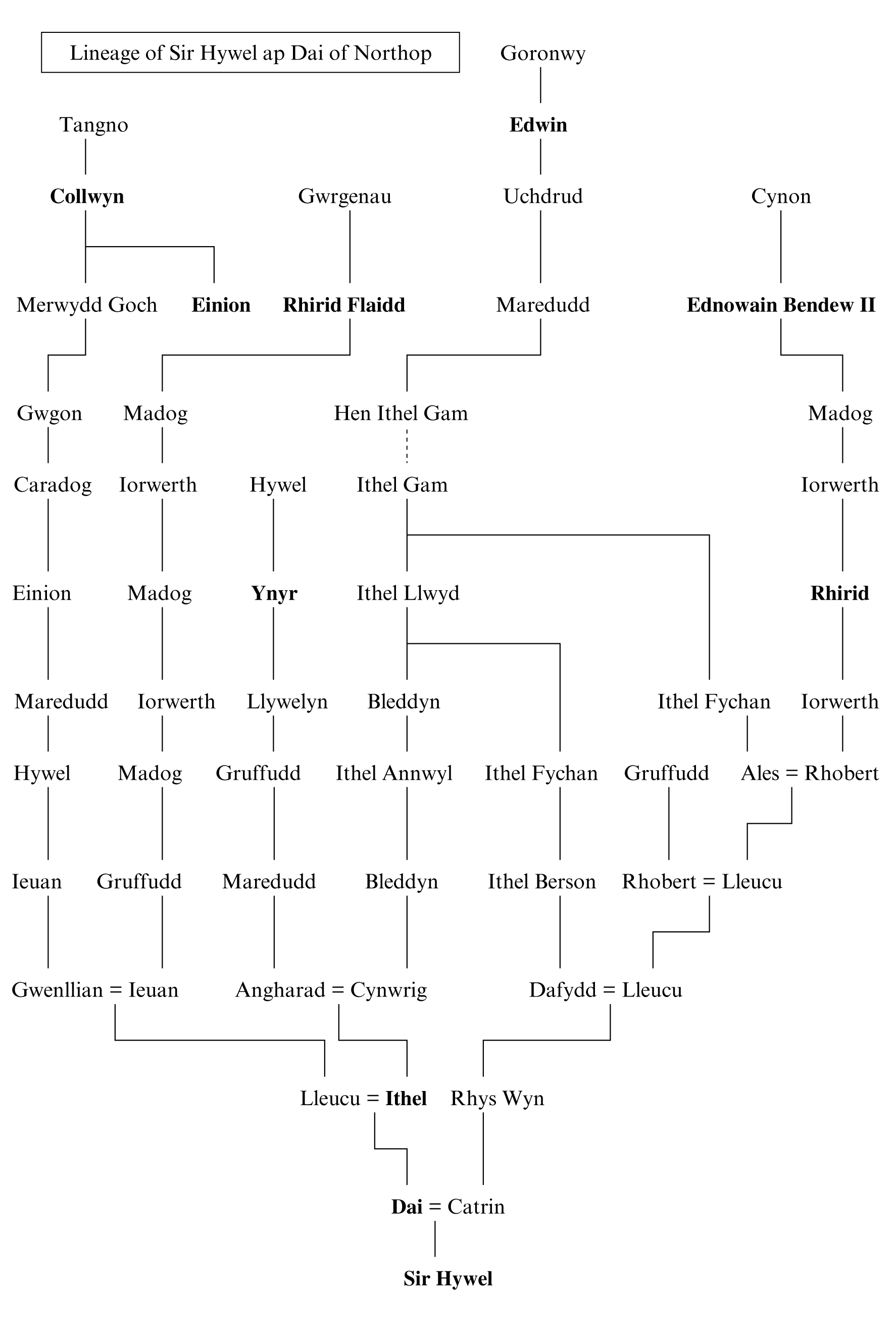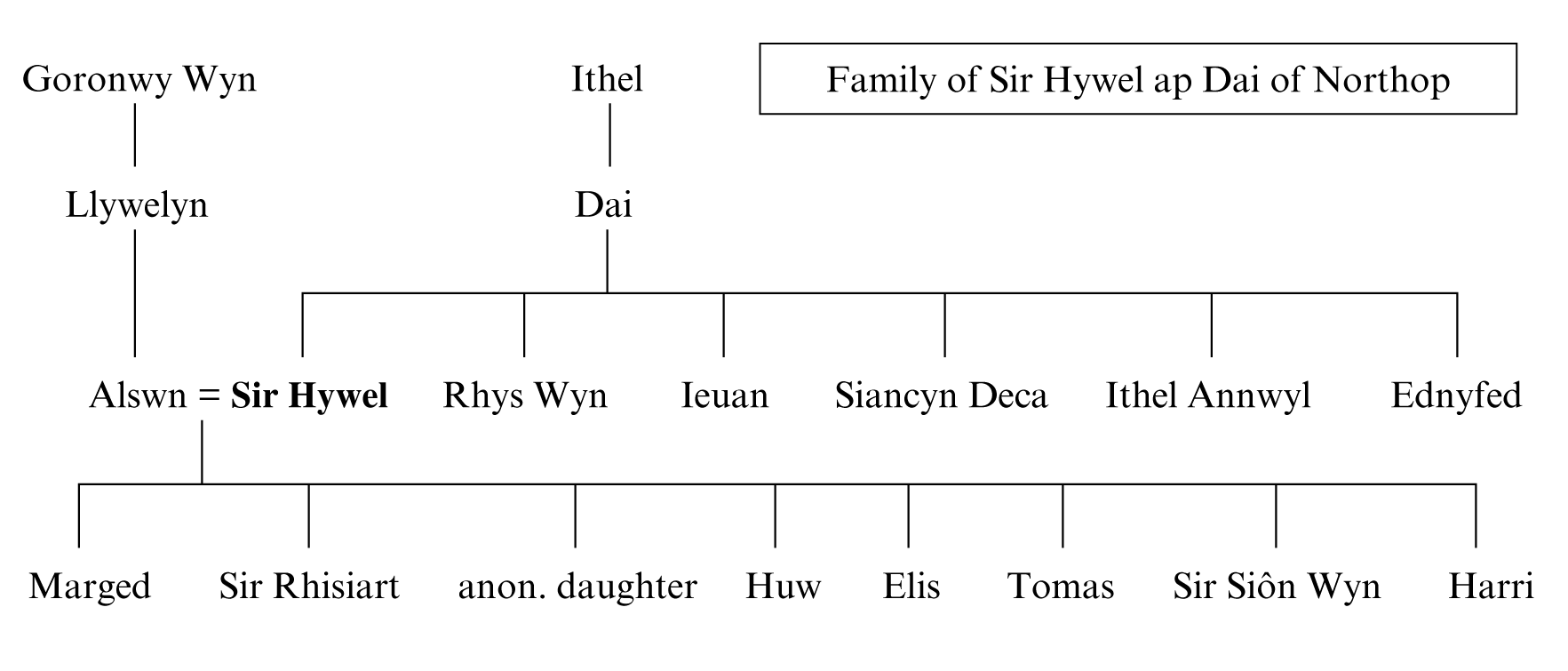Only one poem by Guto for Sir Hywel ap Dai survives, a poem of praise (poem 70). A total of seven other poems for Sir Hywel survive in the manuscripts:
- a poem of praise by Dafydd ab Edmwnd, DE poem LI;
- an overly magnificent poem of praise by Dafydd ab Edmwnd, ibid. poem LII;
- a poem of praise by Gutun Owain, GO poem LIX;
- a part of a poem of praise by Lewys Glyn Cothi, GLGC poem 216;
- a poem by Lewys Môn to request mill stones from Huw Morgan on Sir Hywel’s behalf, GLM poem XIX;
- two elegies by Siôn ap Hywel, GSH poems 3 and 4.
Lineage
The genealogical table below is based on WG1 ‘Ednywain Bendew’ 1, 2; ‘Edwin’ 1, 10, 12, 13, 16; ‘Gollwyn’ 1, 4; ‘Marchudd’ 16; ‘Rhirid Flaidd’ 1, 3, 8; ‘Sandde Hardd’ 2, 9; WG2 ‘Edwin’ 13 C1. Those named in Guto’s poem for Sir Hywel are shown in bold print. A.C. Lake (GSH 125; cf. Williams 1962: 282) noted that Guto and other poets make a point of praising Sir Hywel’s notable lineage. A distinction should be made between him and Hywel ap Dafydd ab Ithel Fychan of Northop, to whom a number of the poets named above addressed their praise.

Lineage of Sir Hywel ap Dai of Northop
The genealogical table below is based on WG1 ‘Iarddur’ 5; WG2 ‘Edwin’ 13 C1 (where it is noted that Sir Rhisiart ap Sir Hywel was parson of Whitford like his father). In DE 161 it is noted that another of Sir Hywel’s sons, Sir Siôn Wyn, was vicar of Mold in 1506, which is corroborated, it seems, in Thomas (1908–13, II: 417), where he is named John ap Howel ap David.

Family of Sir Hywel ap Dai of Northop
His career
According to Thomas (1908–13, I: 331), Sir Hywel was a canon in St Asaph in 1476 and rector of the parish of Whitford by 1484 (ibid. II: 206), where he received an annual pension of ten pounds for administering services in the chapel of St Winifred near St Winifred’s Well in Flintshire. Yet the title of ‘rector’ is misleading, for the earliest example of rheithor belongs to the nineteenth century (GPC 3053 s.v.). Guto calls him a person ‘parson’ (70.3n).
Sir Hywel is the only parson named in the fifteenth century on Thomas’s obviously incomplete list of the parsons of Whitford, therefore he was not necessarily succeeded by one Robert Puleston sometime in the 1520s (as stated in GSH 125). Neither is it clear whether Sir Hywel was appointed parson of Whitford in 1484 (as stated in ibid.) or was already parson there, but the poets routinely associate him with that parish (70.36; DE 104 Person Chwitfordd [sic] rhag gorddwy / pa wr a fynn power fwy ‘Parson of Whitford against oppression, what man desires more power than this?’; GO LIX.31–2 Ffynnon y Baddon i’r byd, / Ffyrdd gwin, yw Chwitffordd genyd! ‘Your Whitford is the Spring of Bath for the world, roads of wine’; GSH 3.75 Aeth Chwitffordd heb ordd, ganbyrddaid – gwinoedd ‘Whitford went without a hammer, hundred tablefuls of wine’, 4.1–2 Chwitffordd, oedd briffordd braffwin, / Sy oer goed heb sawyr gwin ‘Whitford, that was the main road of strong wine, is full of cold wood without the aroma of wine’). Furthermore, the poets’ many references to St Asaph underline Sir Hywel’s association with the church in St Asaph, although it is likely that his close association with that place was in his youth only.
Other poetic references suggest that Sir Hywel’s parsonage was not confined to Whitford only. Guto refers to [t]air persondod ‘three parsonages’, and the note on those words (70.50n) argues that they are a reference to the parishes of Meliden and Northop in the cantref of Englefield and the parish of Marchwiel in the commote of Maelor Gymraeg. Furthermore, Sir Hywel may have held the office of treasurer of St Asaph through his association with Meliden (70.30n Allt Melydn).
A few lines from a poem by Lewys Môn may suggest that both Sir Hywel and Huw Morgan of Anglesey had received university education (GLM XIX.27–32):
Syr Hywel, ail Seirioel, wyf,
bwa dadl, ab Dai ydwyf:
mab yt, ŵr, ymhob taraw,
a chwi’n droed Rhydychen draw:
â nyni yn y neuadd,
a chwi roed yn uwch o radd.
‘I am Sir Hywel ap Dai, a second St Seiriol,
an argument’s bow,
your son, good man, in every exchange,
and you being Oxford’s foot yonder;
we ourselves in the hall,
and you were placed in a higher degree.’
It seems that the theory is supported in Dafydd ab Edmwnd’s poem for Sir Hywel (DE 103–4):
Vrddas gw[a]ed ar ddysgedig
i gyd a roid ag a drig
Gwedi dysg o waed y daw
ac o radd y gair iddaw
A lladin gwyr eilliedig
a rydd fraint lle yr oedd ei frig …
Or tir ni welais wr teg
er moed well ei ramadeg
Ysgolhaig or ysgol hon
vchaf oll oi chyfeillion.
‘Blood’s prestige was given to
a learned man, and it remains;
after learning the word will come
to him through both blood and a degree,
and the Latin of shaved men
will bestow status where its pinnacle was …
I never saw in the land
a fair man so learned in grammar,
a scholar from this school,
the greatest of her companions.’
See further, 70.26n.
Both Charles (1972: 34–5) and Bowen (1994: 86) follow Williams (1962: 282–3) in the opinion that the poetry suggests that Sir Hywel’s ecclesiastic duties came second to his hospitality as a patron:
A cleric in name only, he was married, of course, and to a wife whose family was nearly as illustrious as his own. He would no more have thought of remaining celibate that of assuming parochial cares. He lived in comfort at his family home in Llaneurgain … cultivating his patrimony and keeping hospitality in traditional style. His rectory of Whitford he regarded chiefly as a useful additional source of income – £49 a year Valor Ecclesiasticus rated it – to which a family right must be established. So firmly was that lien maintained that his grandson was still enjoying the rectory in 1563, and it took a long Star Chamber suit by the bishop of St. Asaph to finally dislodge him.
Bibliography
Bowen, D.J. (1994), ‘Beirdd a Noddwyr y Bymthegfed Ganrif’, LlCy 18: 53–89
Charles, R.A. (1972), ‘Noddwyr y Beirdd yn Sir y Fflint’, LlCy 12: 3–44
Thomas, D.R. (1908–13), The History of the Diocese of St. Asaph (3 vols., Oswestry)
Williams, G. (1962), The Welsh Church from Conquest to Reformation (Cardiff)





